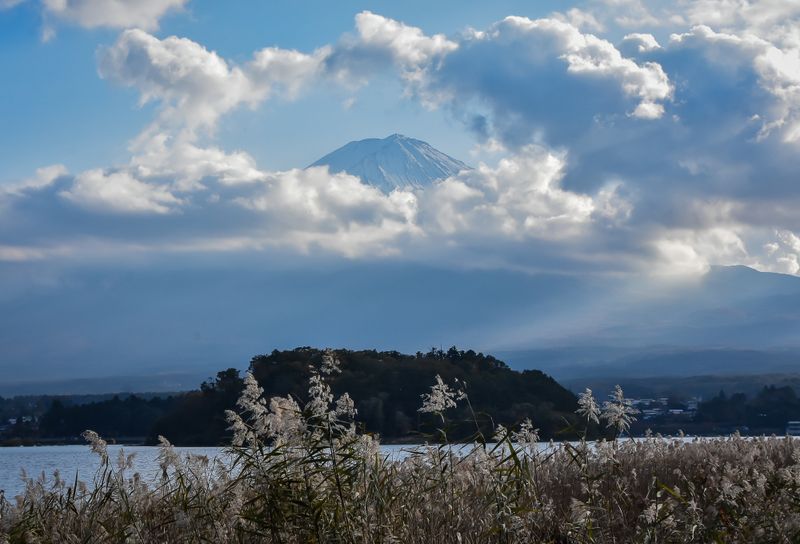Aug 30, 2023
Mt. Fuji “screaming” for new approach to overcrowding crisis, Yamanashi governor

“He who climbs Mt. Fuji once is wise, he who climbs twice is a fool,” goes the Japanese proverb but with the iconic mountain “screaming” under the strain of overcrowding and other environmental issues, would people be foolish to want to climb it at all these days?
When Mt. Fuji opened for the 2023 summer climbing season in July the mountain, which straddles Japan's Yamanashi and Shizuoka prefectures, did so on the back of marking 10 years since its registration as a UNESCO World Heritage site.
While visitors and climbers, previously held back by years of COVID-19 restrictions, have flocked to Mt. Fuji during the summer climbing season this anniversary year, the celebratory mood among officials responsible for the environment of the mountain appears muted.
“To describe the situation of Mt. Fuji right now in one word, that would be “screaming,” Kotaro Nagasaki, the governor of Yamanashi Prefecture, told reporters in Tokyo on Tuesday.

(Screenshot of a livestreamed news conference shows Yamanashi Gov. Kotaro Nagasaki speaking during a news conference in Tokyo on Tuesday.)
At the time of Mt. Fuji’s registration as a World Heritage site on June 22, 2013, those who control the fortunes of the mountain were charged with three main tasks from UNESCO in order to tackle the major threats faced by the mountain and its surrounding environment.
Among the homework set for officials and others was to address the overcrowding, reduce the negative environmental impact of visitors, and deal with artificial landscapes, such as large concrete parking lots, that are a blight on the landscape.
Since becoming a World Heritage site however, the number of visitors to one of the mountain's 5th climbing stations - starting points for trails to the summit which can be accessed by vehicles - has soared during the summer climbing season, according to Nagasaki, more than doubling from around 2.3 million people in 2012 to over 5 million in 2019.
“We were charged with the task of reducing the number of visitors on the mountain but actually the current situation is the complete opposite of that,” the governor said.
The surge in visitors to Mt. Fuji continues to place a strain on the mountain’s infrastructure, particularly at the 5th station where electricity has to be supplied by private power generators and water and fuel brought up by heavy vehicles.
In regards to the treatment of human waste, the governor described the 5th station as having “no lifeline at all.”
A major source of Mt. Fuji’s woes on the Yamanashi Prefecture side appears to be one of its main access points for vehicular traffic, the Fuji Subaru Line toll road which connects the 5th station of the Yoshida entrance to the foot of the mountain.
While law prevents local authorities from closing the road altogether, they have had some success in reducing the number of private vehicles using the road by placing stricter regulations during the climbing season, only to see an increase in the number of large vehicles, including tour buses, which are not subject to the tighter regulations.
“We have been regulating access from private vehicles and making calls for restrictions on climbers but these have had limited effect,” Nagasaki said.
The increase in people on the mountain has also highlighted the need to better or further educate them on how to climb and behave on the slopes.
In particular, an increase in so-called “bullet climbing” has placed extra concern on locals and people who staff the mountain. The practice of climbing to reach the summit in time to see the sunrise without taking a break to sleep overnight furthers the risk of altitude sickness, hyperthermia due to cold early-morning temperatures at the summit, and falls from climbing in the dark.
“I’m convinced that the shift from quantity to quality should be made in regards to tourism on Mt. Fuji. The time has come to discuss this seriously.” Nagasaki said.
On the table then, is what appears to be a dramatic change of approach from the Yamanashi government to improving conditions on Mt. Fuji, in more ways than one.
Nagasaki and his team are in the early stages of proposing the development of a light rail transit system to tackle these issues - offering visitors an alternative way to access the mountain and in such a way that their numbers can be controlled.
Under the Mt. Fuji Mountain Railway Concept an emission-free, next-generation light railway system would replace the Fuji Subaru Line in connecting visitors to the 5th station, thus eliminating the use of private vehicles and affording authorities greater control over the number of people on the mountain through control of train passenger numbers.
So-called “lifelines” to strengthen infrastructure on the mountain could be developed along the railway tracks and the environment of the 5th station would be improved to be in-keeping with Mt. Fuji as an object of worship and a source of art.
The governor and his team plan to carry out a study into the issues involved in realizing the mountain railway as well as engage in consensus building with local residents and stakeholders by the end of FY2023.
Nagasaki said he had been to the 5th station recently and described the crowds there to be like that of Shibuya’s scramble crossing.
“I’m here today to inform as many people in the world as possible about the current situation on Mt. Fuji, what it should be in the future and how it should be handed down to future generations,” he told reporters in Tokyo.



0 Comments